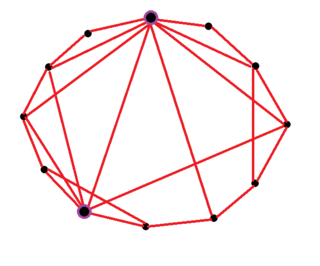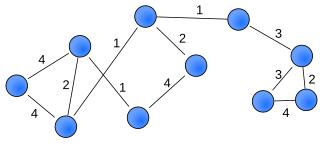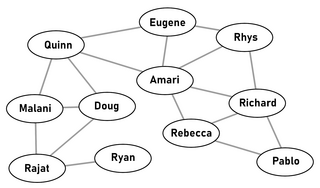
Social dynamics is the study of the behavior of groups and of the interactions of individual group members, aiming to understand the emergence of complex social behaviors among microorganisms, plants and animals, including humans. It is related to sociobiology but also draws from physics and complex system sciences. In the last century, sociodynamics was viewed as part of psychology, as shown in the work: "Sociodynamics: an integrative theorem of power, authority, interfluence and love". In the 1990s, social dynamics began being viewed as a separate scientific discipline[By whom?]. An important paper in this respect is: "The Laws of Sociodynamics". Then, starting in the 2000s, sociodynamics took off as a discipline of its own, many papers were released in the field in this decade.
A complex system is a system composed of many components which may interact with each other. Examples of complex systems are Earth's global climate, organisms, the human brain, infrastructure such as power grid, transportation or communication systems, complex software and electronic systems, social and economic organizations, an ecosystem, a living cell, and ultimately the entire universe.

The small-world experiment comprised several experiments conducted by Stanley Milgram and other researchers examining the average path length for social networks of people in the United States. The research was groundbreaking in that it suggested that human society is a small-world-type network characterized by short path-lengths. The experiments are often associated with the phrase "six degrees of separation", although Milgram did not use this term himself.

In mathematics, computer science and network science, network theory is a part of graph theory. It defines networks as graphs where the nodes or edges possess attributes. Network theory analyses these networks over the symmetric relations or asymmetric relations between their (discrete) components.

A small-world network is a graph characterized by a high clustering coefficient and low distances. On an example of social network, high clustering implies the high probability that two friends of one person are friends themselves. The low distances, on the other hand, mean that there is a short chain of social connections between any two people. Specifically, a small-world network is defined to be a network where the typical distance L between two randomly chosen nodes grows proportionally to the logarithm of the number of nodes N in the network, that is:
In graph theory, a clustering coefficient is a measure of the degree to which nodes in a graph tend to cluster together. Evidence suggests that in most real-world networks, and in particular social networks, nodes tend to create tightly knit groups characterised by a relatively high density of ties; this likelihood tends to be greater than the average probability of a tie randomly established between two nodes.

In the context of network theory, a complex network is a graph (network) with non-trivial topological features—features that do not occur in simple networks such as lattices or random graphs but often occur in networks representing real systems. The study of complex networks is a young and active area of scientific research inspired largely by empirical findings of real-world networks such as computer networks, biological networks, technological networks, brain networks, climate networks and social networks.

Steven Henry Strogatz, born August 13, 1959, is an American mathematician and author, and the Susan and Barton Winokur Distinguished Professor for the Public Understanding of Science and Mathematics at Cornell University. He is known for his work on nonlinear systems, including contributions to the study of synchronization in dynamical systems, and for his research in a variety of areas of applied mathematics, including mathematical biology and complex network theory.

The Watts–Strogatz model is a random graph generation model that produces graphs with small-world properties, including short average path lengths and high clustering. It was proposed by Duncan J. Watts and Steven Strogatz in their article published in 1998 in the Nature scientific journal. The model also became known as the (Watts) beta model after Watts used to formulate it in his popular science book Six Degrees.

Network science is an academic field which studies complex networks such as telecommunication networks, computer networks, biological networks, cognitive and semantic networks, and social networks, considering distinct elements or actors represented by nodes and the connections between the elements or actors as links. The field draws on theories and methods including graph theory from mathematics, statistical mechanics from physics, data mining and information visualization from computer science, inferential modeling from statistics, and social structure from sociology. The United States National Research Council defines network science as "the study of network representations of physical, biological, and social phenomena leading to predictive models of these phenomena."
Mark Newman is an English–American physicist and Anatol Rapoport Distinguished University Professor of Physics at the University of Michigan, as well as an external faculty member of the Santa Fe Institute. He is known for his fundamental contributions to the fields of complex networks and complex systems, for which he was awarded the 2014 Lagrange Prize.

A weighted network is a network where the ties among nodes have weights assigned to them. A network is a system whose elements are somehow connected. The elements of a system are represented as nodes and the connections among interacting elements are known as ties, edges, arcs, or links. The nodes might be neurons, individuals, groups, organisations, airports, or even countries, whereas ties can take the form of friendship, communication, collaboration, alliance, flow, or trade, to name a few.
The Matthew effect of accumulated advantage, sometimes called the Matthew principle, is the tendency of individuals to accrue social or economic success in proportion to their initial level of popularity, friends, and wealth. It is sometimes summarized by the adage or platitude "the rich get richer and the poor get poorer". The term was coined by sociologists Robert K. Merton and Harriet Zuckerman in 1968 and takes its name from a loose interpretation of the Parable of the Talents in the biblical Gospel of Matthew.

Evolving networks are networks that change as a function of time. They are a natural extension of network science since almost all real world networks evolve over time, either by adding or removing nodes or links over time. Often all of these processes occur simultaneously, such as in social networks where people make and lose friends over time, thereby creating and destroying edges, and some people become part of new social networks or leave their networks, changing the nodes in the network. Evolving network concepts build on established network theory and are now being introduced into studying networks in many diverse fields.
In social network analysis, the co-stardom network represents the collaboration graph of film actors i.e. movie stars. The co-stardom network can be represented by an undirected graph of nodes and links. Nodes correspond to the movie star actors and two nodes are linked if they co-starred (performed) in the same movie. The links are un-directed, and can be weighted or not depending on the goals of study. If the number of times two actors appeared in a movie is needed, links are assigned weights. The co-stardom network can also be represented by a bipartite graph where nodes are of two types: actors and movies. And edges connect different types of nodes if they have a relationship. Initially the network was found to have a small-world property. Afterwards, it was discovered that it exhibits a scale-free (power-law) behavior.

A social network is a social structure made up of a set of social actors, sets of dyadic ties, and other social interactions between actors. The social network perspective provides a set of methods for analyzing the structure of whole social entities as well as a variety of theories explaining the patterns observed in these structures. The study of these structures uses social network analysis to identify local and global patterns, locate influential entities, and examine network dynamics.

Six degrees of separation is the idea that all people are six or fewer social connections away from each other. As a result, a chain of "friend of a friend" statements can be made to connect any two people in a maximum of six steps. It is also known as the six handshakes rule.

Global cascades models are a class of models aiming to model large and rare cascades that are triggered by exogenous perturbations which are relatively small compared with the size of the system. The phenomenon occurs ubiquitously in various systems, like information cascades in social systems, stock market crashes in economic systems, and cascading failure in physics infrastructure networks. The models capture some essential properties of such phenomenon.
The initial attractiveness is a possible extension of the Barabási–Albert model. The Barabási–Albert model generates scale-free networks where the degree distribution can be described by a pure power law. However, the degree distribution of most real life networks cannot be described by a power law solely. The most common discrepancies regarding the degree distribution found in real networks are the high degree cut-off and the low degree saturation. The inclusion of initial attractiveness in the Barabási–Albert model addresses the low-degree saturation phenomenon.

Matthew Jeffrey Salganik is an American sociologist and professor of sociology at Princeton University with a special interest on social networks and computational social science.










